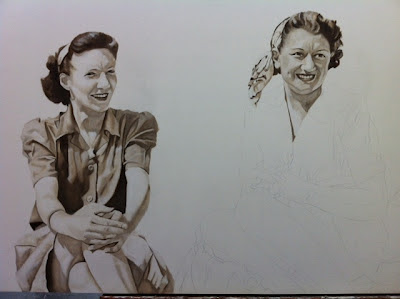Lately I have been teaching myself calculus while also taking an advance open studio class on Flemish classical realism. You would think that learning calculus would be the harder of the two, but suprisingly, I find it easier to learn and retain.
 |
The closed grisaille stage of my painting. I will need to do one more black and
white layer before adding color. |
While calculus is challenging, it is math afterall, I find it to be just a series of puzzles with multiple ways of solving it but only one solution. The fact that there is only one solution is comforting to me. I am either right or wrong. If I am wrong, I can go over my steps to see if there are any mistakes, or try something new. I don't have any pre-conceived notions about it, nor do I have any bad habits with math that get in the way of my learning.
Flemish-style classical realism, on the other hand, is kicking my ass. I have been frustrated and bored at the same time, multiple times. I find that since I already know how to paint, even though it is not the same style, I am at a disadvantage. I am not a clean slate that a teacher can impart wisdom on with no previous experience that gets in the way. I am an old dog. Felmish style painting is my new trick, and as the saying goes, "you can't teach an old dog new tricks".
 |
| One of two pieces I am currently working on. |
While I don't believe that to actually be true, I do know that teaching an "old dog" something new is VERY difficult. I find that I am resistant subconciously (perhaps even somewhat consciously) of painting in a new style. I have my methods that I have been using for years. I have habits, good and bad, that make me who I am as an artist. I am not a clean slate. As my teacher said yesterday during class "I see that you understand what to do conceptually but your old style and bad habits have a stronger hold and keep pulling you towards them". She is right. I would start off making short, soft strokes with my brush, as I am supposed to do, and a few minutes later, the strokes would become longer and crisp edges appear. Instead of picking a spot and painting the areas around it, I would pick an object and fill it in like a paint by numbers. If I had a dollar for everytime Sadie, my teacher, walked by me and said " We are not house painters here, we are artists" (meaning I was using long strokes again), or "this is not a paint by numbers" I would have at least enough to buy myself a nice dinner.
 |
The second painting I am working on. I am struggling with their mouths at
the moment... |
So here I am struggling to learn and use a different method of painting and feeling like I am failing. If you look at my painting, you'd probably think that it looks pretty good. I would probably agree with you. But for a method that is very process and technique heavy, I am failing miserably. I'm sure this is where someone will chime in that I paint well enough, why bother with this method? I bother because I like the challenge of learning something new, no matter how much I am frustrated by the process. I bother because as an artist I am always trying to learn and try something new. I bother because I know in the end, it will be worth it. And lastly, I bother because while I am an "old dog", learning something new keeps me young. It keeps me from being stagnant. It keeps my life interesting. Failure may be what I am experiencing now, but with failure comes knowledge, and with knowledge we become better artists.


















